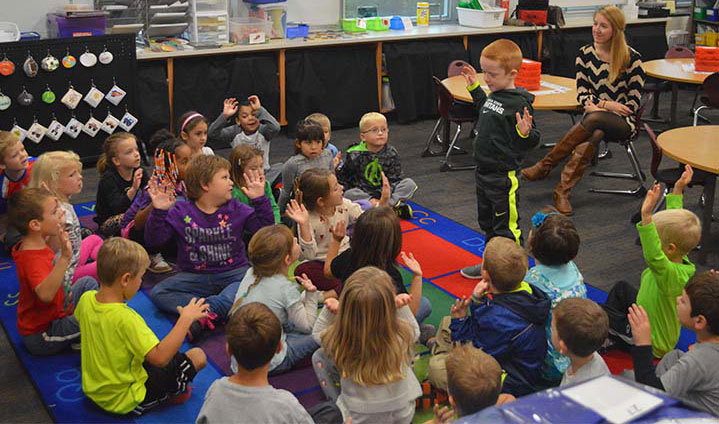Stacey Byl has had her current group of kindergartners for exactly 20 school days, and already they seem particularly, well, engaged.
“Class class,” she says, not loudly or particularly soft.
“Yes yes,” all her students respond, their voices matching Byl’s.
“Mirror,” Byl says.
5 In-Class Rules of Whole Brain Teaching
Source: Whole Brain Teaching |
“Mirror,” they repeat in her exact tone, and to a one the kindergartners raise both hands, elbows pulled in tight.
The lesson today is predictions, what they are and how they work, with help from a book involving an old red tractor named Otis.
Byl’s lesson lasts an hour, but with the frequent use of changing gestures, activities and group participation, it doesn’t feel anywhere close to that. And given the students’ attention that remains when it’s time to line up at the door for lunch, time clearly did not go slowly for them either.
“Make smart choices,” says Sophia Stolsky as she taps her temple with a finger. Sophia is trying to recite the five classroom rules of this teaching and learning method called Whole Brain Teaching before lunchtime. She’s clearly torn that there isn’t time to share them all.
“Maybe you can meet me outside?” she asks a visitor.
Engaged, Focused, Learning
That enthusiasm is a big reason Byl is sold on whole brain teaching. She first learned about it seven years ago when she was switching from special education to elementary teaching and she came across a YouTube video.
“It’s about classroom management and about learning at the same time,” Byl said. “All the techniques have to do with how the brain works, how to keep it engaged. And the kids love it, I mean, they love it, because they’re having fun. They’re engaged and they’re focused.”
It is not known how prevalent whole brain teaching is throughout Kent County, but Byl said as many as 100 k-sixth-grade teachers at Grandville Public Schools are using the practice in their classrooms. Some use “class, yes” and that’s all, she said. Others integrate more of the practice into their lessons.
“I certainly would not push it on anybody, but it’s worth trying for anyone who wants to breathe new life into their teaching,” she said. “With all the challenges we’ve had to student engagement in the last 10 years… electronics, lack of sleep… I think any of us would want to try whatever we can.”
Byl also led a workshop on whole brain teaching over the summer that was attended by some 60 educators, most from districts other than Grandville, she said.
Teresa McDougall, Kent ISD instructional coach who helps teachers set up and connect with professional development opportunities, said as word is getting out about whole brain teaching, more and more teachers want to try it.

Looking at the Data
Like most anything, there are skeptics.
“I think any time we hear the term ‘whole brain,’ or about groups of kids responding in unison, it brings up negative images,” McDougall said. “It might sound hokey, and it might appear hokey at first, but when you see the outcomes, it’s pretty impressive. And it’s not just an early childhood thing; it’s something that can be used into adulthood.”
She said it has been reported that students who use whole brain teaching show an increase in language development, higher level thinking skills and writing ability.
“By the end of the school year they will be writing complete paragraphs with no trouble,” Byl said of her kindergartners. “And my kids are learning concepts, like how to predict and to summarize. Often when kids see those concepts on a test, they freeze.”
One youngster who seems destined for wordsmithery is Trevor Stevens, who isn’t mincing words when he declares “I like talking.”
Whole brain teaching — which he knows for now as ‘class yes,’ “gets us our attention better,” he explains. But he’s not ready to put it to use at home.
“We don’t even raise our hand at home,” Trevor said. “I just tap my mom. It’s fine.”
CONNECT
Whole Brain Teaching Primer from PBS










